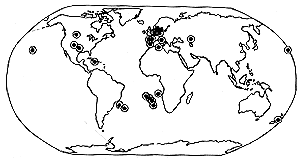

STUDYING EXTINCTIONS
Studying extinction events is by no means a precise art. There are numerous problems that have to be dealt with when studying extinctions in the geologic record. Hypotheses formulated to explain extinctions deal with these problems by usually making assumptions; this leaves a lot of theories susceptible to being attacked for those very assumptions.
Extinction theories have to deal with problems relating to:
1) Inadequate Fossil Record: this is a major problem. For the large part, the fossil record - as it stands presently - is largely incomplete. Only a fraction of all living species were fossilized. And even less of those fossils have been discovered. Therefore, any hypotheses based on the fossil record involve a marginal amount of assumptions and interpretations. For example, the absence of a large number of fossils near the Cretaceous-Tertiary boundary is attributed to a mass extinction. However the extent of the extinction could be exaggerated by the absence of fossils, which could be nothing more than the fossils not being preserved or fossils not having been discovered yet.
2) Incompleteness of the Sedimentary Record: even if the fossils do preserve, there is also the chance that the rocks they are preserved in do not last. 50 to 90% of rock record is not preserved. There a number of geological events (such as weathering, erosion, etc) that can erase the evidence of preservation. It is often difficult to find complete stratigraphic sections for a certain period. This again leads to hampering the efforts of paleontologists to understand when or how species went extinct.
3) Restrictive Number of K/T localities: regarding the K/T extinction, there are only 20 localities worldwide that withhold evidence of what occurred at the K/T boundary. All the hypotheses currently under consideration have relied on evidence from these 20 sites. Many argue that the restrictive number of these sites disavows the evidence being truly representative of a global phenomenon. The majority of the sites are found terrestrially, and very little evidence is from marine sediments. This is due to the fact that ocean lithosphere is subducted much more regularly than continental lithosphere is. So there is a marginal absence of marine sites. Out of these 20 sites, much of the research has been conducted in a only a few of the localities; ones that were found to provide better evidence than the others. This again leads to the argument that the data is not representative of what happened globally.

Figure: Location of Cretaceous-Tertiary boundary sites worldwide.